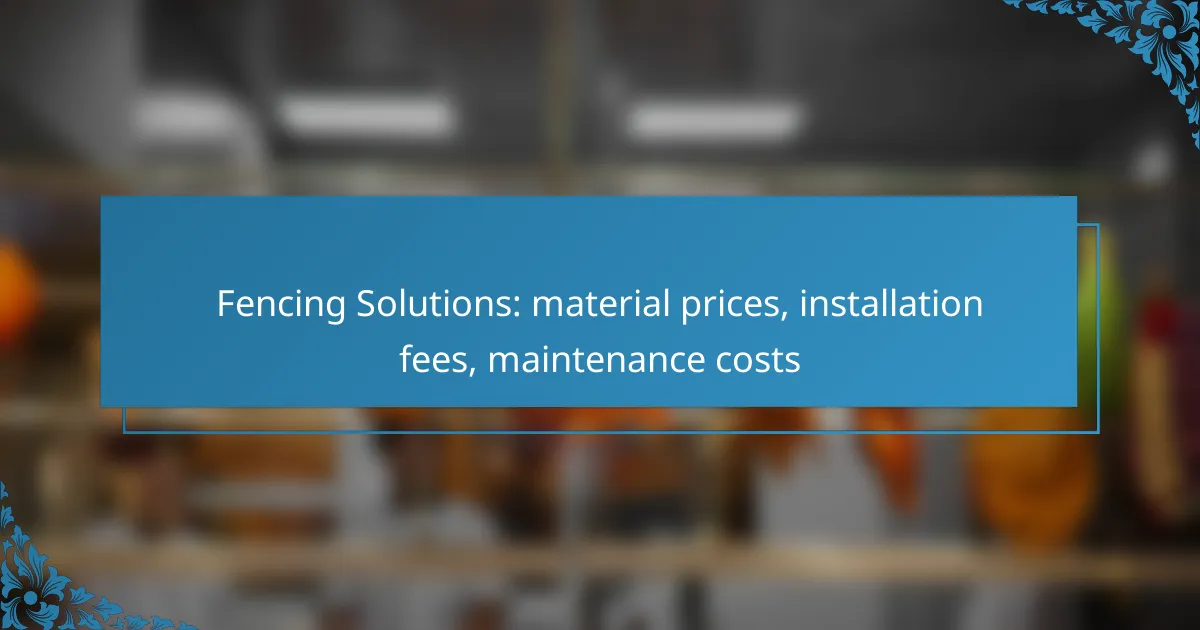When considering fencing solutions, it’s important to understand the varying costs associated with materials, installation, and maintenance. In Australia, material prices can range from budget-friendly options like chain link to pricier choices such as composite and metal. Installation fees typically fall between AUD 50 to AUD 100 per meter, influenced by material type and project complexity, while ongoing maintenance costs depend on the material and environmental factors. Being informed about these expenses can help you make the best decision for your fencing needs.
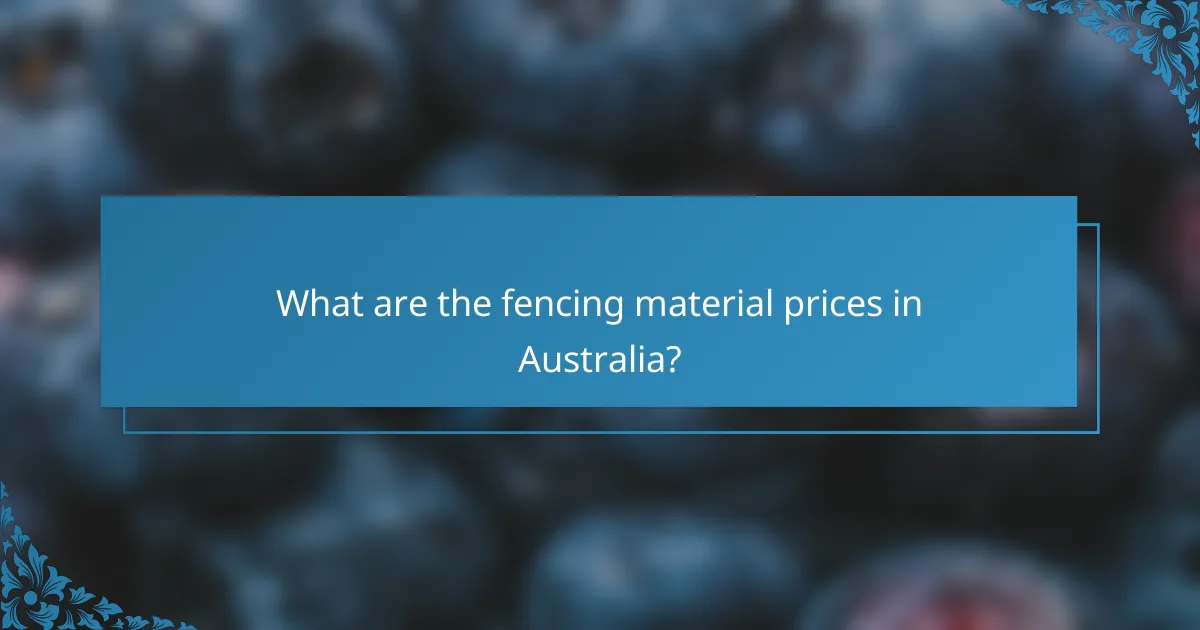
What are the fencing material prices in Australia?
Fencing material prices in Australia vary significantly based on the type of material chosen. Generally, costs can range from affordable options like chain link to more expensive choices such as composite and metal fencing.
Wood fencing costs
Wood fencing typically ranges from AUD 75 to AUD 150 per linear meter, depending on the type of wood and design. Treated pine is often the most economical choice, while hardwoods like cedar or redwood can be pricier.
When considering wood fencing, factor in the need for regular maintenance, such as staining or sealing, to prolong its lifespan. This can add to the overall cost over time.
Vinyl fencing costs
Vinyl fencing usually costs between AUD 100 and AUD 200 per linear meter. This material is popular for its durability and low maintenance requirements, as it does not need painting or staining.
While the initial investment is higher than wood, vinyl can be more cost-effective in the long run due to its longevity and resistance to weathering and pests.
Metal fencing costs
Metal fencing, including options like aluminum and wrought iron, typically ranges from AUD 150 to AUD 300 per linear meter. Aluminum is lightweight and resistant to rust, while wrought iron offers a classic aesthetic but may require more maintenance.
Consider the security needs of your property when choosing metal fencing, as it can provide a strong barrier against intruders.
Composite fencing costs
Composite fencing prices generally fall between AUD 150 and AUD 250 per linear meter. This material combines wood fibers and plastic, offering the appearance of wood with enhanced durability and minimal maintenance.
Composite fencing is an excellent choice for those seeking an environmentally friendly option, as it often contains recycled materials.
Chain link fencing costs
Chain link fencing is one of the most affordable options, with costs ranging from AUD 30 to AUD 60 per linear meter. It is a practical choice for enclosing large areas without a significant financial investment.
While chain link provides visibility and security, it may not offer the same aesthetic appeal as other fencing types. Consider adding privacy slats if visual barriers are a concern.
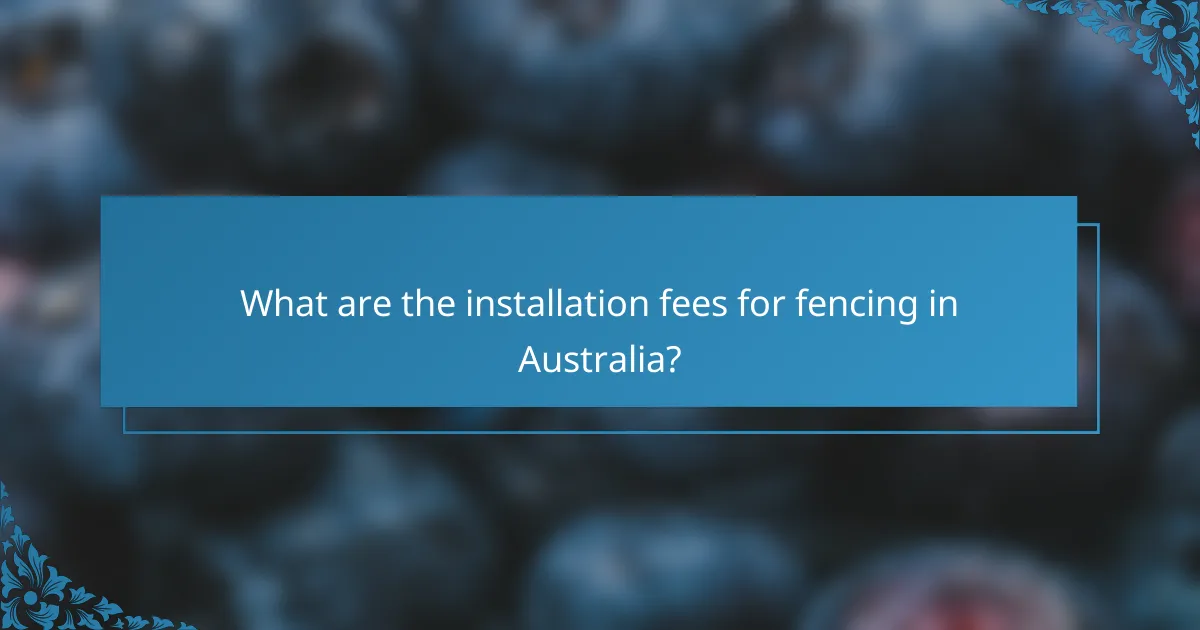
What are the installation fees for fencing in Australia?
Installation fees for fencing in Australia typically range from AUD 50 to AUD 100 per meter, depending on the type of material and complexity of the project. Additional costs may arise from site preparation, permits, and labor, which can significantly affect the total expense.
Average labor costs
Labor costs for fencing installation in Australia generally fall between AUD 30 and AUD 70 per hour. The total labor expense will depend on the length of the fence, the type of material used, and the experience level of the installers. For a standard installation, you might expect labor to account for about 40% to 60% of the total installation cost.
Factors affecting installation fees
Several factors can influence installation fees for fencing. These include the type of fencing material (e.g., wood, vinyl, metal), the terrain of the installation site, and any necessary permits or inspections. Additionally, the complexity of the design and the height of the fence can lead to variations in costs.
For example, installing a wooden fence on a flat surface may be less expensive than a wrought iron fence on a sloped area. Always consider these factors when budgeting for your fencing project.
DIY vs professional installation
Choosing between DIY and professional installation can significantly impact your fencing costs. DIY installation can save you labor costs, but it requires time, tools, and some level of skill. If you opt for DIY, ensure you research local regulations and obtain any necessary permits.
On the other hand, hiring professionals can provide a quicker, more reliable installation, especially for complex projects. While this option is more expensive upfront, it may save you money in the long run by avoiding potential mistakes and ensuring compliance with local standards.
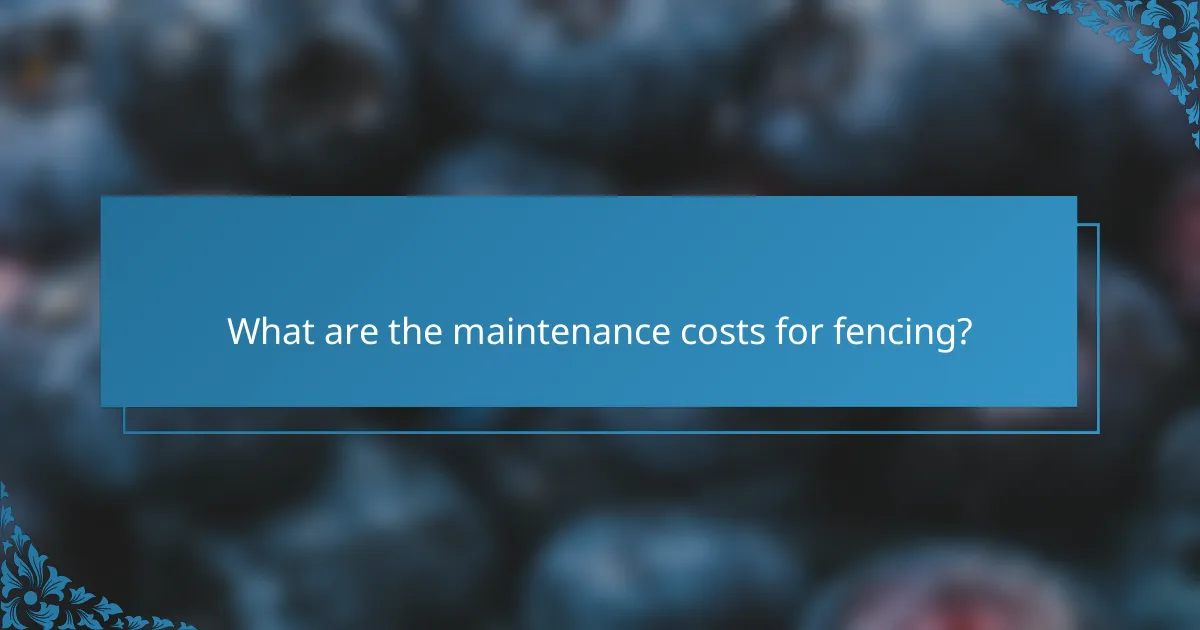
What are the maintenance costs for fencing?
Maintenance costs for fencing vary significantly based on the material used, the local climate, and the level of care required. Regular upkeep can prevent costly repairs and extend the life of your fence, making it essential to understand these expenses.
Wood fencing maintenance costs
Wood fencing typically requires the highest maintenance costs due to its susceptibility to weather damage, pests, and rot. Homeowners should expect to spend around $200 to $500 annually on treatments such as staining or sealing, which help protect the wood from moisture and UV damage.
Regular inspections are crucial; look for signs of wear or damage at least twice a year. Prompt repairs can prevent more extensive damage and higher costs down the line.
Vinyl fencing maintenance costs
Vinyl fencing is known for its low maintenance requirements, making it a cost-effective option in the long run. Annual maintenance costs are generally minimal, often under $100, primarily involving occasional cleaning with soap and water to remove dirt and stains.
While vinyl is resistant to fading and does not require painting or staining, it is essential to check for cracks or damage after severe weather events to avoid costly repairs.
Metal fencing maintenance costs
Metal fencing, including aluminum and wrought iron, usually incurs moderate maintenance costs. Homeowners can expect to spend around $100 to $300 annually on rust prevention treatments and minor repairs. Regular inspections for rust and corrosion are essential to maintain the fence’s integrity.
Applying a protective coating every few years can significantly extend the life of metal fencing. Additionally, ensure that any scratches or chips are promptly addressed to prevent rust from developing.

How to choose the right fencing material?
Choosing the right fencing material involves considering factors like durability, cost, and maintenance requirements. Each material has its own strengths and weaknesses, which can significantly impact your long-term satisfaction and investment.
Durability considerations
Durability is a critical factor when selecting fencing materials, as it determines how well the fence will withstand environmental conditions and wear over time. Materials like vinyl and metal tend to offer higher longevity compared to wood, which may require more frequent repairs or replacements.
Consider local climate conditions when assessing durability. For example, areas with high humidity may lead to quicker deterioration of wood fences, while metal fences can rust if not properly treated. Opting for galvanized or powder-coated metal can enhance resistance to corrosion.
Cost-effectiveness analysis
Cost-effectiveness involves evaluating both the initial investment and the long-term expenses associated with different fencing materials. While wood may be cheaper upfront, its maintenance costs can add up, making materials like vinyl or composite more appealing in the long run.
Installation fees also vary by material. For instance, chain-link fences typically have lower installation costs compared to wooden or vinyl options, which may require more labor-intensive setups. Always factor in potential maintenance costs, as some materials may need regular upkeep, impacting overall value.
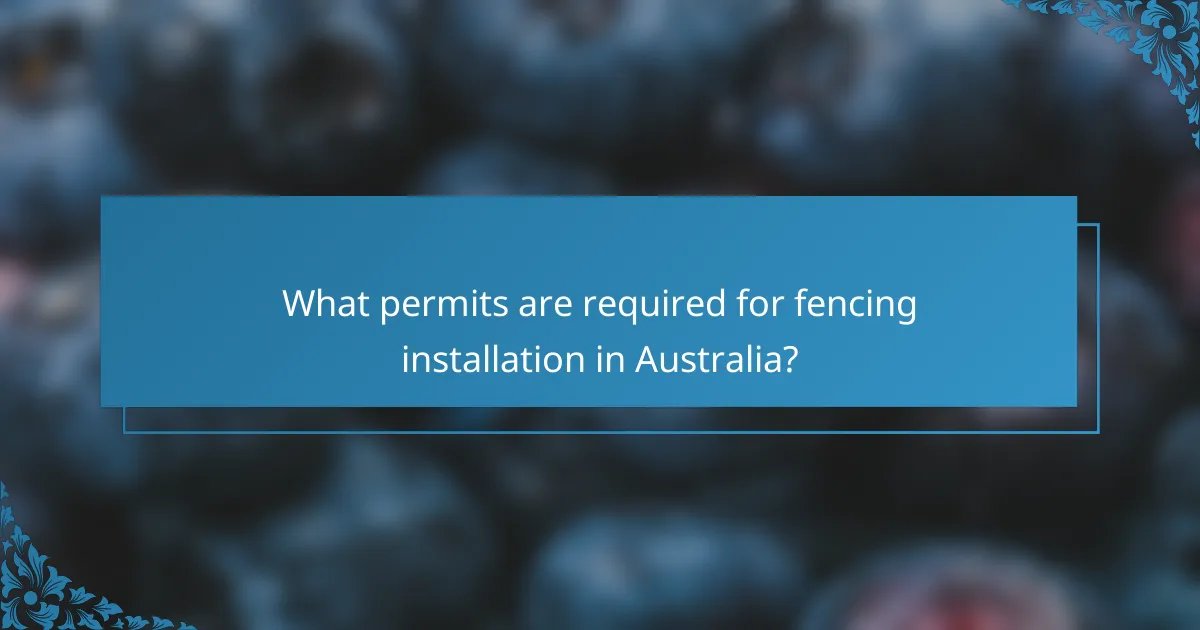
What permits are required for fencing installation in Australia?
In Australia, fencing installation typically requires permits that vary by state and local council regulations. It’s essential to check with your local council to ensure compliance with specific requirements before proceeding with your project.
Local council regulations
Local councils in Australia have specific regulations regarding fencing, which can include height restrictions, materials allowed, and boundary setbacks. These rules are designed to maintain aesthetic standards and ensure safety within neighborhoods.
Before starting your fencing project, consult your local council’s planning department. They can provide guidance on any necessary permits and inform you about community standards that may affect your installation.
Building permits for fences
In some cases, a building permit may be required for fence construction, especially for taller or more complex designs. This permit ensures that the fence meets safety and structural standards.
To obtain a building permit, you may need to submit plans detailing the fence’s design and location. Fees for building permits can vary widely, so it’s advisable to budget for this expense when planning your fencing project.

What are the common fencing styles in Australia?
In Australia, popular fencing styles include colorbond, timber, and chain link. Each style offers distinct benefits and aesthetic qualities, catering to various needs and preferences.
Colorbond Fencing
Colorbond fencing is a durable and low-maintenance option made from pre-painted steel. It is available in a range of colors, allowing homeowners to choose a style that complements their property. This type of fencing is particularly resistant to harsh weather conditions, making it suitable for various Australian climates.
Installation costs for Colorbond fencing typically range from AUD 75 to AUD 150 per meter, depending on the height and complexity of the project. Maintenance is minimal, usually requiring only occasional cleaning to remove dirt and debris.
Timber Fencing
Timber fencing offers a classic and natural look, often used for privacy and boundary marking. Common timber types include treated pine, hardwood, and cedar, each providing different aesthetics and durability levels. Timber can be stained or painted to enhance its appearance and longevity.
Installation costs for timber fencing generally fall between AUD 50 and AUD 100 per meter. Regular maintenance, such as staining or sealing, is essential to prevent rot and insect damage, which can add to long-term costs.
Chain Link Fencing
Chain link fencing is a practical and cost-effective choice, ideal for security and containment. It consists of woven wire mesh and is often used in commercial properties, parks, and residential backyards. While it may not provide privacy, it allows visibility and airflow.
The installation price for chain link fencing usually ranges from AUD 30 to AUD 70 per meter. Maintenance is straightforward, typically involving rust prevention treatments and occasional tightening of the mesh.
